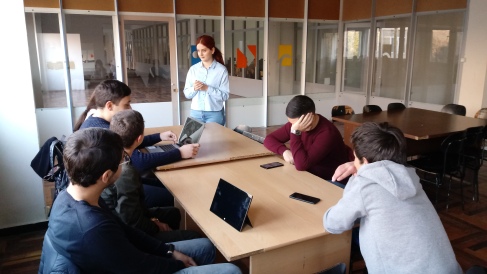Դաս-առաջադրանք Միջին դպրոցի հեռավար ուսուցմամբ սովորողների համար. նոյեմբերի 30-ին
I. A Text for Reading
Bicycle Revolution
Like all big cities, Paris has a traffic (երթևեկություն) problem: lots of cars, lots of traffic jams (խցանումներ) and lots of pollution (աղտոտվածություն) from exhaust fumes (արտանետվող գազեր). So in 2007, the city began a free bicycle project (անվճար հեծանվային նախագիծ) to improve (լավացնել, բարելավել) the situation.
Now people can take a bicycle, use it for as long as they want, and then leave it at the same place or another bicycle station. The first half-hour on the bike is free (անվճար), but if you don’t return it after 30 minutes, you have to pay. But it’s only €1 a day or €29 a year! The bicycles are heavy (25kg), and they are all grey and have baskets. There are about 20,000 of them in the city, and around 1,450 bicycle stations. So there are more bicycle stations than metro stations.
A city spokesman said, “The free bicycle project won’t solve all our traffic problems, of course. But it might reduce pollution levels (մակարդակ) in the atmosphere. Traffic, together with factory fumes (գործարանային արտանետումներ), is a big problem. Everyone knows about global warming and dramatic climate changes – we know this is partly because rainforests (արևադարձային անտառները, որտեղ հորդառատ անձրևներ են գալիս) are disappearing (անհետանալ). But it’s also because there is so much pollution in the world and we can help improve the situation right here. The bikes might help people to lead a healthier (ավելի առողջ) life, too. There aren’t any simple answers to traffic problems and pollution in cities. But unless we do something now, there will be more traffic jams and temperatures will continue to rise, so the problems in our environment (շրջակա միջավայր) will get worse.”
- Do you think we can use the same free bicycle project in Yerevan?
- How can we reduce air pollution in Yerevan?
II. Translate the following sentences into English using the vocabulary of the text. (Առաջին հայացքից թվում է, որ դժվար թարգմանություն է, բայց դուք կարող եք հեշտությամբ թարգմանել, եթե տեքստից օգտվեք):
- Երևանում կան շատ ավտոմեքենաներ, երթևեկության շատ խցանումներ, իսկ օդն էլ շատ աղտոտված է արտանետվող գազերից.
- Եթե մարդիկ սկսեն էլեկտրոմոբիլներ վարել, նրանք կկրճատեն մթնոլորտի աղտոտվածության մակարդակը:
- Տարիներ առաջ շատ գործարաններ կային Երևանում և օդի աղտոտվածությունը գործարանային արտանետումների պատճառով էր:
- Համընդհանուր տաքացումը և կլիմայի դրամատիկ փոփոխությունները մեծ խնդիրներ են մարդկանց համար:
- Մեր շրջակա միջավայրի խնդիրները կվատանան եթե շարունակենք աղտոտել օդը և ջուրը:
New vocabulary – նոր բառապաշար
recycle – վերամշակել
recycling – վերամշակում
pollute – աղտոտել
litter – աղբ
waste – վատնել
հայերենի «աղբաման» բառը անգլերենում մի քանի ձևով կարելի է արտահայտել՝ waste paper basket -օգտագործված թղթի աղբաման, litter box – փողոցի աղբաման, rubbish can – աղբաման
Օգտագործեք վերը նշված բառերը այս նախադասություններում.
- Don’t drop … on the pavement.
- We will … the empty plastic bottles. Leave them here.
- Water is important and has limits. Don’t … it.
- Factories and cars … the air we breathe.
- Drop litter into the ….
Առաջադրանքը կատարել են՝
Աստղիկ Հակոբյանը՝ դեկտեմբերի 1-ին: Նույն օրը պատասխանել եմ սխալների ուղղումով և իմ բացատրություններով:




 –
–
